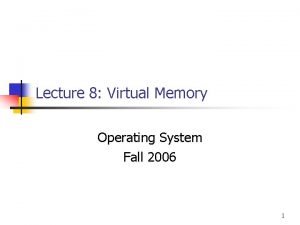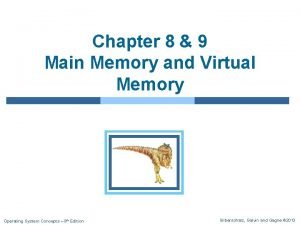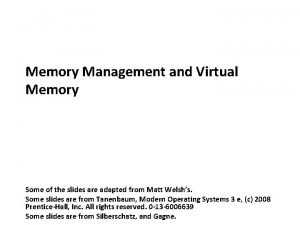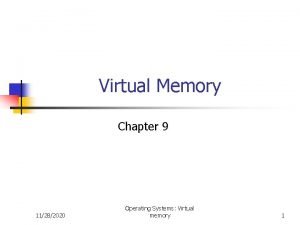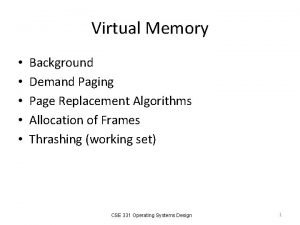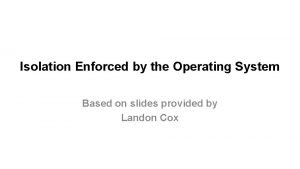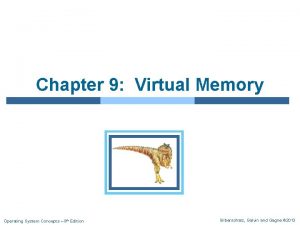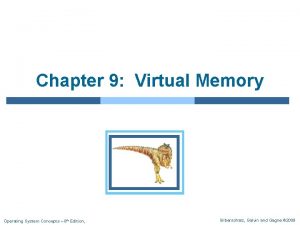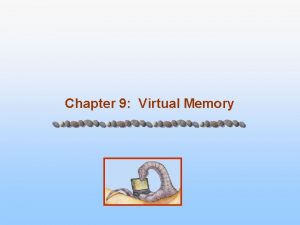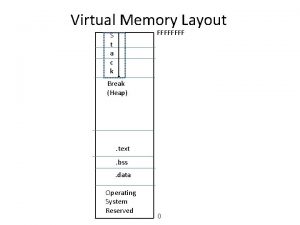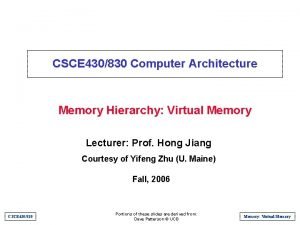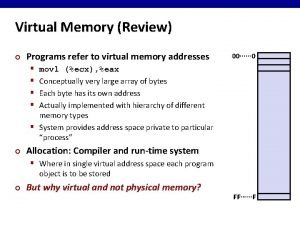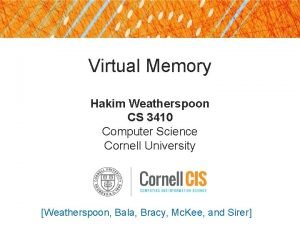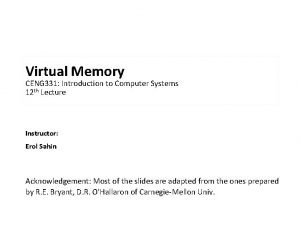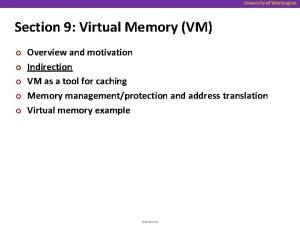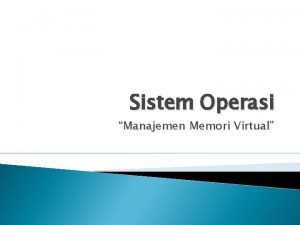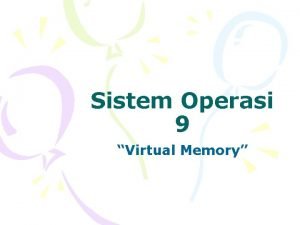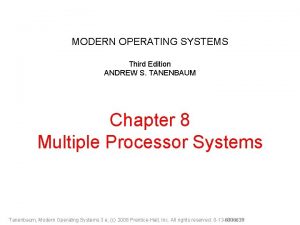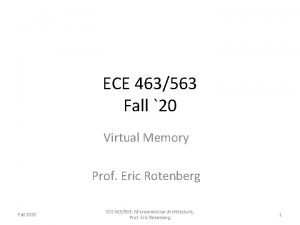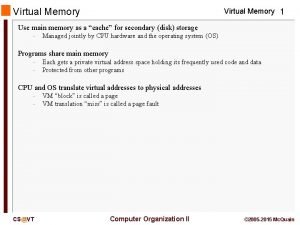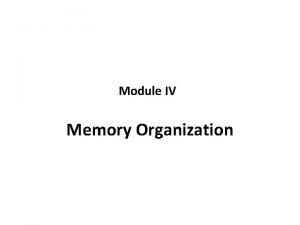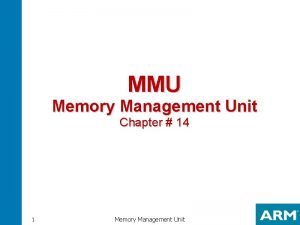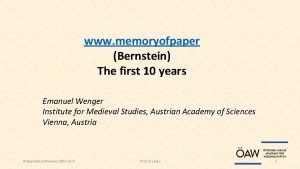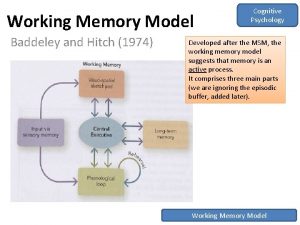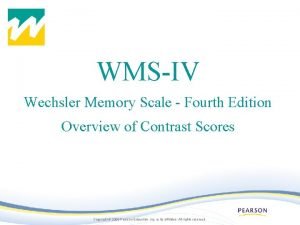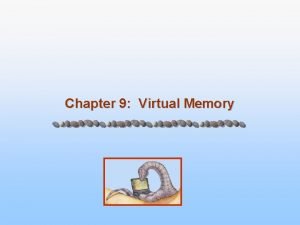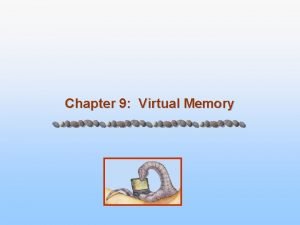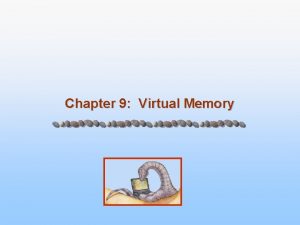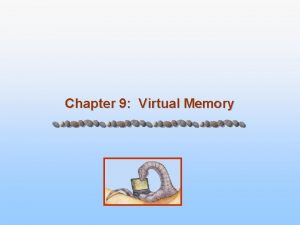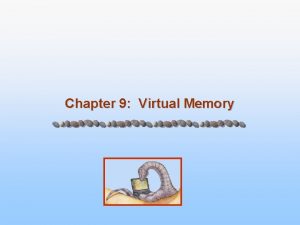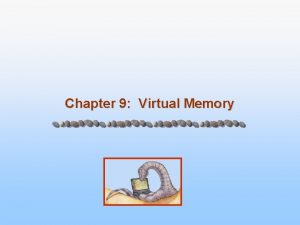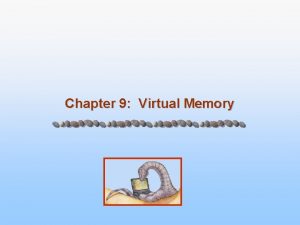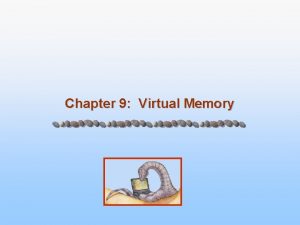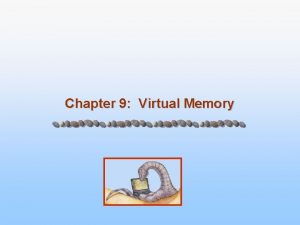Chapter 9 Virtual Memory Chapter 9 Virtual Memory





























































![Other Issues – Program Structure n Program structure Int[128, 128] data; l Each row Other Issues – Program Structure n Program structure Int[128, 128] data; l Each row](https://slidetodoc.com/presentation_image_h/814bd9fec2872b923c00a170976e3a0e/image-62.jpg)



- Slides: 65

Chapter 9: Virtual Memory

Chapter 9: Virtual Memory n Background n Demand Paging n Process Creation n Page Replacement n Allocation of Frames n Thrashing n Demand Segmentation n Operating System Examples Operating System Concepts 9. 2 Silberschatz, Galvin and Gagne © 2005

Background n Ch. 8 requires the instructions being executed must be in physical memory. l Dynamic loading eases the restriction, but need special care by the programmer l Not good, limiting the size of a program n Virtual memory – separation of user logical memory from physical memory. l Only part of the program needs to be in memory for execution. l Logical address space can therefore be much larger than physical address space. l Allows address spaces to be shared by several processes. l Allows for more efficient process creation. Why? n Virtual memory can be implemented via: l Demand paging l Demand segmentation Operating System Concepts 9. 3 Silberschatz, Galvin and Gagne © 2005

Virtual Memory That is Larger Than Physical Memory Operating System Concepts 9. 4 Silberschatz, Galvin and Gagne © 2005

Virtual-address Space Operating System Concepts 9. 5 Silberschatz, Galvin and Gagne © 2005

Shared Library Using Virtual Memory Operating System Concepts 9. 6 Silberschatz, Galvin and Gagne © 2005

Demand Paging n Bring a page into memory only when it is needed l Less I/O needed ? l Less memory needed l Faster response ? l More users n Page is needed reference to it l invalid reference abort l not-in-memory bring to memory Operating System Concepts 9. 7 Silberschatz, Galvin and Gagne © 2005

Transfer of a Paged Memory to Contiguous Disk Space Operating System Concepts 9. 8 Silberschatz, Galvin and Gagne © 2005

Valid-Invalid Bit n With each page table entry a valid–invalid bit is associated (1 in-memory, 0 not-in-memory) Initially valid–invalid but is set to 0 on all entries n Example of a page table snapshot: n Frame # valid-invalid bit 1 1 0 0 0 page table n During address translation, if valid–invalid bit in page table entry is 0 page fault Operating System Concepts 9. 9 Silberschatz, Galvin and Gagne © 2005

Page Table When Some Pages Are Not in Main Memory Operating System Concepts 9. 10 Silberschatz, Galvin and Gagne © 2005

Page Fault n If there is ever a reference to a page, first reference will trap to OS page fault by paging hardware OS looks at another table (usually kept with PCB) to decide: l Invalid reference abort. l Just not in memory. n Get empty frame. What happens if there are no empty frame? n Swap page into frame. n Reset tables, validation bit = 1. n Restart instruction: Least Recently Used l block move n l auto increment/decrement location Operating System Concepts 9. 11 Silberschatz, Galvin and Gagne © 2005

Steps in Handling a Page Fault Operating System Concepts 9. 12 Silberschatz, Galvin and Gagne © 2005

What happens if there is no free frame? Operating System Concepts 9. 13 Silberschatz, Galvin and Gagne © 2005

What happens if there is no free frame? n Page replacement – find some page in memory, but not really in use (how do you know? ), swap it out l algorithm l performance – want an algorithm which will result in minimum number of page faults n Same page may be brought into memory several times Operating System Concepts 9. 14 Silberschatz, Galvin and Gagne © 2005

Performance of Demand Paging n Page Fault Rate 0 p 1. 0 l if p = 0 no page faults l if p = 1, every reference is a fault n Effective Access Time (EAT) EAT = (1 – p) x memory access + p (page fault overhead + [swap page out ] + swap page in + restart overhead) Question: is this right? What does page fault overhead mean? Operating System Concepts 9. 15 Silberschatz, Galvin and Gagne © 2005

Demand Paging Example n Memory access time = 1 microsecond n 50% of the time the page that is being replaced has been modified and therefore needs to be swapped out n Swap Page Time = 10 msec = 10, 000 microsec EAT = (1 – p) x 1 + p (15000) = 1 + 15000 P Operating System Concepts (in microsec) 9. 16 Silberschatz, Galvin and Gagne © 2005

Process Creation n Virtual memory allows other benefits during process creation: - Copy-on-Write - Memory-Mapped Files (later) Operating System Concepts 9. 17 Silberschatz, Galvin and Gagne © 2005

Copy-on-Write n Copy-on-Write (COW) allows both parent and child processes to initially share the same pages in memory (e. g. fork()) If either process modifies a shared page, only then is the page copied n COW allows more efficient process creation as only modified pages are copied n Free pages are allocated from a pool of zeroed-out pages Operating System Concepts 9. 18 Silberschatz, Galvin and Gagne © 2005

Page Replacement n What should OS do for page replacement? l Discussions, questions, comments? Operating System Concepts 9. 19 Silberschatz, Galvin and Gagne © 2005

Page Replacement n Prevent over-allocation of memory by modifying page-fault service routine to include page replacement n Use modify (dirty) bit to reduce overhead of page transfers – only modified pages are written to disk n Page replacement completes separation between logical memory and physical memory – large virtual memory can be provided on a smaller physical memory Operating System Concepts 9. 20 Silberschatz, Galvin and Gagne © 2005

Need For Page Replacement Operating System Concepts 9. 21 Silberschatz, Galvin and Gagne © 2005

Basic Page Replacement 1. Find the location of the desired page on disk 2. Find a free frame: - If there is a free frame, use it - If there is no free frame, use a page replacement algorithm to select a victim frame 3. Read the desired page into the (newly) free frame. Update the page and frame tables. 4. Restart the process Operating System Concepts 9. 22 Silberschatz, Galvin and Gagne © 2005

Page Replacement Operating System Concepts 9. 23 Silberschatz, Galvin and Gagne © 2005

Page Replacement Algorithms n Goal: lowest page-fault rate n Evaluate algorithm by running it on a particular string of memory references (reference string) and computing the number of page faults on that string n In all our examples, the reference string is 1, 2, 3, 4, 1, 2, 5, 1, 2, 3, 4, 5 Operating System Concepts 9. 24 Silberschatz, Galvin and Gagne © 2005

Graph of Page Faults Versus The Number of Frames Operating System Concepts 9. 25 Silberschatz, Galvin and Gagne © 2005

First-In-First-Out (FIFO) Algorithm n Reference string: 1, 2, 3, 4, 1, 2, 5, 1, 2, 3, 4, 5 n 3 frames (3 pages can be in memory at a time per process) n n 4 frames 1 1 4 5 2 2 1 3 3 3 2 4 1 1 5 4 2 2 1 5 3 3 2 4 4 3 9 page faults 10 page faults FIFO Replacement – Belady’s Anomaly l more frames more page faults Operating System Concepts 9. 26 Silberschatz, Galvin and Gagne © 2005

FIFO Page Replacement Operating System Concepts 9. 27 Silberschatz, Galvin and Gagne © 2005

FIFO Illustrating Belady’s Anomaly Operating System Concepts 9. 28 Silberschatz, Galvin and Gagne © 2005

Optimal Algorithm n Replace page that will not be used for longest period of time n 4 frames example 1, 2, 3, 4, 1, 2, 5, 1, 2, 3, 4, 5 1 4 2 6 page faults 3 4 5 n How do you know this? n Used for measuring how well your algorithm performs Operating System Concepts 9. 29 Silberschatz, Galvin and Gagne © 2005

Optimal Page Replacement Operating System Concepts 9. 30 Silberschatz, Galvin and Gagne © 2005

Least Recently Used (LRU) Algorithm n Reference string: 1, 2, 3, 4, 1, 2, 5, 1, 2, 3, 4, 5 1 5 2 Operating System Concepts 3 5 4 3 4 9. 31 Silberschatz, Galvin and Gagne © 2005

LRU Page Replacement Operating System Concepts 9. 32 Silberschatz, Galvin and Gagne © 2005

LRU Implementation n How do we implement LRU? Operating System Concepts 9. 33 Silberschatz, Galvin and Gagne © 2005

LRU Implementation n Counter implementation l Every page entry has a counter; every time page is referenced through this entry, copy the clock into the counter l When a page needs to be changed, look at the counters to determine which are to change Operating System Concepts 9. 34 Silberschatz, Galvin and Gagne © 2005

LRU Algorithm (Cont. ) n Stack implementation – keep a stack of page numbers in a double link form: l Page referenced: 4 move it to the top 4 requires l 6 pointers to be changed No search for replacement Operating System Concepts 9. 35 Silberschatz, Galvin and Gagne © 2005

Use Of A Stack to Record The Most Recent Page References Operating System Concepts 9. 36 Silberschatz, Galvin and Gagne © 2005

LRU Implementation n Do previous LRU implementations have problems? Operating System Concepts 9. 37 Silberschatz, Galvin and Gagne © 2005

LRU Approximation Algorithms n FEW computer systems provide sufficient hardware support for true LRU page replacement l Every mem. access need update the clock field or stack, expensive!!! n Reference bit (set by hardware whenever accessing) l With each page associate a bit, initially = 0 l When page is referenced bit set to 1 l Replace the one which is 0 (if one exists). We do not know the order, however. n Additional-reference-bits alg. l 8 -bit byte for each page l Periodically, reference bit go to the high-order of 8 -bit byte, shifting the other bits by 1 bit and discarding the low -order bit Operating System Concepts 9. 38 Silberschatz, Galvin and Gagne © 2005

LRU Approximation Algorithms n Second chance (FIFO replacement) l Need reference bit l Clock replacement l If page to be replaced has reference bit = 0, then replace it l If page to be replaced (in clock order) has reference bit = 1 then: give 2 nd chance!!! 4 set reference bit 0 4 leave page in memory (put it into the end of the queue) 4 replace l Operating System Concepts next page (in clock order), subject to same rules Using circular queue (FIFO) but dynamically changing pointer (indicating the page to be replaced next)!! 9. 39 Silberschatz, Galvin and Gagne © 2005

Second-Chance (clock) Page-Replacement Algorithm Operating System Concepts 9. 40 Silberschatz, Galvin and Gagne © 2005

Counting Algorithms n Keep a counter of the number of references that have been made to each page n LFU Algorithm: replaces page with smallest count l Problems? n MFU Algorithm: based on the argument that the page with the smallest count was probably just brought in and has yet to be used Operating System Concepts 9. 41 Silberschatz, Galvin and Gagne © 2005

Allocation of Frames n Each process needs minimum number of pages n Example: IBM 370 – 6 pages to handle SS MOVE instruction: l instruction is 6 bytes, might span 2 pages l 2 pages to handle from l 2 pages to handle to n Two major allocation schemes l fixed allocation l priority allocation Operating System Concepts 9. 42 Silberschatz, Galvin and Gagne © 2005

Fixed Allocation n Equal allocation – For example, if there are 100 frames and 5 processes, give each process 20 frames. n Proportional allocation – Allocate according to the size of process Operating System Concepts 9. 43 Silberschatz, Galvin and Gagne © 2005

Priority Allocation n Use a proportional allocation scheme using priorities rather than size n If process Pi generates a page fault, l select for replacement one of its frames l select for replacement a frame from a process with lower priority number Operating System Concepts 9. 44 Silberschatz, Galvin and Gagne © 2005

Global vs. Local Allocation n Global replacement – process selects a replacement frame from the set of all frames; one process can take a frame from another n Local replacement – each process selects from only its own set of allocated frames Operating System Concepts 9. 45 Silberschatz, Galvin and Gagne © 2005

Thrashing n If a process does not have “enough” pages, the page-fault rate is very high. This leads to: l low CPU utilization l operating system thinks that it needs to increase the degree of multiprogramming l another process added to the system n Thrashing a process is busy swapping pages in and out l High paging activity l A process is in thrashing if it is spending more time paging than executing Operating System Concepts 9. 46 Silberschatz, Galvin and Gagne © 2005

Thrashing (Cont. ) Operating System Concepts 9. 47 Silberschatz, Galvin and Gagne © 2005

Demand Paging and Thrashing n Why does demand paging work? Locality model l Process migrates from one locality to another l Localities may overlap n Why does thrashing occur? size of locality > total memory size Operating System Concepts 9. 48 Silberschatz, Galvin and Gagne © 2005

Locality In A Memory-Reference Pattern Operating System Concepts 9. 49 Silberschatz, Galvin and Gagne © 2005

Working-Set Model n working-set window a fixed number of page references Example: 10, 000 instruction n WSSi (working set of Process Pi) = total number of pages referenced in the most recent (varies in time) l if too small will not encompass entire locality l if too large will encompass several localities l if = will encompass entire program n D = WSSi total demand frames n if D > m Thrashing n Policy if D > m, then suspend one of the processes Operating System Concepts 9. 50 Silberschatz, Galvin and Gagne © 2005

Working-set model Operating System Concepts 9. 51 Silberschatz, Galvin and Gagne © 2005

Keeping Track of the Working Set n Approximate with interval timer + a reference bit n Example: = 10, 000 l Timer interrupts after every 5000 time units l Keep in memory 2 history bits (not the reference bit) for each page l Whenever a timer interrupts copy and sets the values of all reference bits to 0 l If one of the bits in memory = 1 page in working set n Why is this not completely accurate? n Improvement = 10 bits and interrupt every 1000 time units Operating System Concepts 9. 52 Silberschatz, Galvin and Gagne © 2005

Page-Fault Frequency Scheme n Establish “acceptable” page-fault rate l If actual rate too low, process loses frame l If actual rate too high, process gains frame Operating System Concepts 9. 53 Silberschatz, Galvin and Gagne © 2005

Memory-Mapped Files n Memory-mapped file I/O allows file I/O to be treated as routine memory access by mapping a disk block to a page in memory n A file is initially read using demand paging. A page-sized portion of the file is read from the file system into a physical page. Subsequent reads/writes to/from the file are treated as ordinary memory accesses. n Simplifies file access by treating file I/O through memory rather than read() write() system calls n Also allows several processes to map the same file allowing the pages in memory to be shared Operating System Concepts 9. 54 Silberschatz, Galvin and Gagne © 2005

Memory Mapped Files Operating System Concepts 9. 55 Silberschatz, Galvin and Gagne © 2005

Memory-Mapped Files in Java import java. io. *; import java. nio. channels. *; public class Memory. Map. Read. Only { // Assume the page size is 4 KB public static final int PAGE SIZE = 4096; public static void main(String args[]) throws IOException { Random. Access. File in. File = new Random. Access. File(args[0], "r"); File. Channel in = in. File. get. Channel(); Mapped. Byte. Buffer mapped. Buffer = in. map(File. Channel. Map. Mode. READ ONLY, 0, in. size()); long num. Pages = in. size() / (long)PAGE SIZE; if (in. size() % PAGE SIZE > 0) ++num. Pages; Operating System Concepts 9. 56 Silberschatz, Galvin and Gagne © 2005

Memory-Mapped Files in Java (cont) // we will "touch" the first byte of every page int position = 0; for (long i = 0; i < num. Pages; i++) { byte item = mapped. Buffer. get(position); position += PAGE SIZE; } in. close(); in. File. close(); } } n The API for the map() method is as follows: map(mode, position, size) Operating System Concepts 9. 57 Silberschatz, Galvin and Gagne © 2005

Other Issues -- Prepaging n Prepaging l To reduce the large number of page faults that occurs at process startup l Prepage all or some of the pages a process will need, before they are referenced l But if prepaged pages are unused, I/O and memory wasted l Assume s pages are prepaged and α of the pages is used 4 Is cost of s * α save pages faults > or < than the cost of prepaging s * (1 - α) unnecessary pages? 4α Operating System Concepts near zero prepaging loses 9. 58 Silberschatz, Galvin and Gagne © 2005

Other Issues – Page Size n What should page size selection consider? Operating System Concepts 9. 59 Silberschatz, Galvin and Gagne © 2005

Other Issues – Page Size n Page size selection must take into consideration: l fragmentation l table size l I/O overhead l locality Operating System Concepts 9. 60 Silberschatz, Galvin and Gagne © 2005

Other Issues – TLB Reach n TLB Reach - The amount of memory accessible from the TLB n TLB Reach = (TLB Size) X (Page Size) n Ideally, the working set of each process is stored in the TLB. Otherwise there is a high degree of page faults. n Increase the Page Size. This may lead to an increase in fragmentation as not all applications require a large page size n Provide Multiple Page Sizes. This allows applications that require larger page sizes the opportunity to use them without an increase in fragmentation. Operating System Concepts 9. 61 Silberschatz, Galvin and Gagne © 2005
![Other Issues Program Structure n Program structure Int128 128 data l Each row Other Issues – Program Structure n Program structure Int[128, 128] data; l Each row](https://slidetodoc.com/presentation_image_h/814bd9fec2872b923c00a170976e3a0e/image-62.jpg)
Other Issues – Program Structure n Program structure Int[128, 128] data; l Each row is stored in one page l Program 1 for (j = 0; j <128; j++) for (i = 0; i < 128; i++) data[i, j] = 0; l 128 x 128 = 16, 384 page faults l Program 2 for (i = 0; i < 128; i++) for (j = 0; j < 128; j++) data[i, j] = 0; 128 page faults Operating System Concepts 9. 62 Silberschatz, Galvin and Gagne © 2005

Other Issues – I/O interlock n I/O Interlock – Pages must sometimes be locked into memory n Consider I/O. Pages that are used for copying a file from a device must be locked from being selected for eviction by a page replacement algorithm. Operating System Concepts 9. 63 Silberschatz, Galvin and Gagne © 2005

Exercise n Consider a demand-paging system with the following time- measured utilizations: CPU utilization 20% Paging disk 97. 7% Other I/O devices 5% For each of the following, say whether it will (or is likely to) improve CPU utilization. Explain your answers. [1] Install a faster CPU [2] Increase the degree of multiprogramming [3] Decrease the degree of multiprogramming [4] Install more memory [5] Increase the page size Operating System Concepts 9. 64 Silberschatz, Galvin and Gagne © 2005

End of Chapter 9
 Virtual memory
Virtual memory Virtual memory in memory hierarchy consists of
Virtual memory in memory hierarchy consists of Semantic memory example
Semantic memory example Explicit memory
Explicit memory Long term memory vs short term memory
Long term memory vs short term memory Internal memory and external memory
Internal memory and external memory Primary memory and secondary memory
Primary memory and secondary memory Logical and physical address in os
Logical and physical address in os Which memory is the actual working memory?
Which memory is the actual working memory? Eidetic memory vs iconic memory
Eidetic memory vs iconic memory Shared memory vs distributed memory
Shared memory vs distributed memory Virtualmemory
Virtualmemory Belady's anomaly example
Belady's anomaly example Virtual memory in operating system
Virtual memory in operating system Virtual memory in operating system
Virtual memory in operating system Virtual memory advantages
Virtual memory advantages Explain virtual memory in computer architecture
Explain virtual memory in computer architecture Demand paging in virtual memory
Demand paging in virtual memory Virtual memory in os
Virtual memory in os Multilevel page tables
Multilevel page tables Virtual memory os
Virtual memory os Virtual memory
Virtual memory Virtual memory segmentation
Virtual memory segmentation Tlb computer architecture
Tlb computer architecture Virtual memory os
Virtual memory os Virtual memory os
Virtual memory os Virtual memory is commonly implemented by
Virtual memory is commonly implemented by Virtual memory
Virtual memory Virtual memory os
Virtual memory os Shared pages
Shared pages Virtual memory
Virtual memory Virtual memory
Virtual memory Stack memory layout
Stack memory layout Lokalitas dan memori virtual
Lokalitas dan memori virtual Csce 430
Csce 430 Tlb computer architecture
Tlb computer architecture Virtual memory reddit
Virtual memory reddit Page fault
Page fault Virtual memory
Virtual memory Virtual memory
Virtual memory Virtual memory
Virtual memory G mail
G mail Implementasi virtual memory
Implementasi virtual memory Implementasi virtual memory
Implementasi virtual memory Shared virtual memory
Shared virtual memory Virtual memory
Virtual memory Virtual memory demand paging
Virtual memory demand paging What is virtual memory
What is virtual memory Virtual memory address translation
Virtual memory address translation Virtual memory
Virtual memory Nachos virtual memory
Nachos virtual memory Nachos virtual memory
Nachos virtual memory Virtual memory organization
Virtual memory organization Memory management unit
Memory management unit What are the characteristics of paging ?
What are the characteristics of paging ? What is virtual memory
What is virtual memory Virtual memory areas
Virtual memory areas Has virtual functions and accessible non-virtual destructor
Has virtual functions and accessible non-virtual destructor Chapter 10 memory and thought answers
Chapter 10 memory and thought answers Chapter 6 memory psychology
Chapter 6 memory psychology Source amnesia
Source amnesia Bernstein watermarks
Bernstein watermarks Working memory model
Working memory model Kf memory case study
Kf memory case study Wechsler memory scale scoring
Wechsler memory scale scoring What is memory
What is memory















